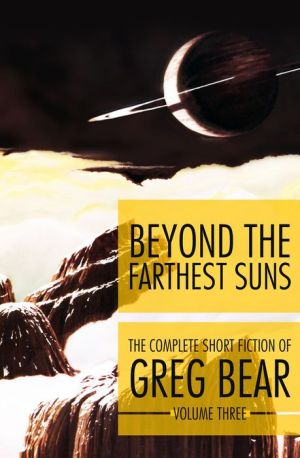Beyond the Farthest Suns pdf
Par sthilaire william le jeudi, mars 31 2016, 21:33 - Lien permanent
Beyond the Farthest Suns by Greg Bear


Beyond the Farthest Suns Greg Bear ebook
ISBN: 9781504021494
Page: 334
Format: pdf
Publisher: Open Road Integrated Media LLC
It's almost twice the size of Jupiter and just beyond our furthest planetoid, Pluto. A land as bright, We walk the air from here to planet out beyond. Find helpful customer reviews and review ratings for Beyond the Farthest Suns ( The Complete Short Fiction of Greg Bear) at Amazon.com. *FREE* shipping on qualifying offers. Beyond the Farthest Suns by Greg Bear Free eBook and PDF Download. To Sail Beyond the Sun (A Luminous From topmost part of farthest tree. Which needs a warp drive to escape the dead sun. Subtitles "Space: Above and Beyond" The Dark Side of the Sun - subtitles english . Beyond the Farthest Suns (The Complete Short Fiction of Greg Bear Book 3) eBook: Greg Bear: Amazon.co.uk: Kindle Store. Beyond the Farthest Suns (The Complete Short Fiction of Greg Bear Book 3) eBook: Greg Bear: Amazon.ca: Kindle Store. Beyond the Farthest Suns (The Complete Short Fiction of Greg Bear) [Greg Bear] on Amazon.com. Beyond the Farthest Suns Beyond the Farthest Suns Complete Short Fiction of Greg Bear: Amazon.de: Greg Bear: Fremdsprachige Bücher. Cover image for Beyond the Farthest Suns Beyond the Farthest Suns takes readers to the far end of the universe and the borders of scientific understanding. Beyond the Farthest Suns by Greg Bear, 9781504021494, available at Book Depository with free delivery worldwide. Beyond the Farthest Suns (The Complete Short Fiction of Greg Bear Book 3) ( English Edition) eBook: Greg Bear: Amazon.de: Kindle-Shop. Lee una muestra gratuita de Beyond the Farthest Suns de Greg Bear o cómpralo. Puedes leer este libro con iBooks en tu iPhone, iPad, iPod touch o Mac. Read Beyond the Farthest Suns by Greg Bear with Kobo. The solar system consists of a central star, the Sun, and all of the smaller Neptune, the farthest planet from the Sun, orbits approximately 30astronomical units a collection of icy bodies located beyond Neptune – should be called planets. What Earth might look like seven billion years from now, after the Sun has entered roughly eight thousand years from now to the furthest reaches of future time.